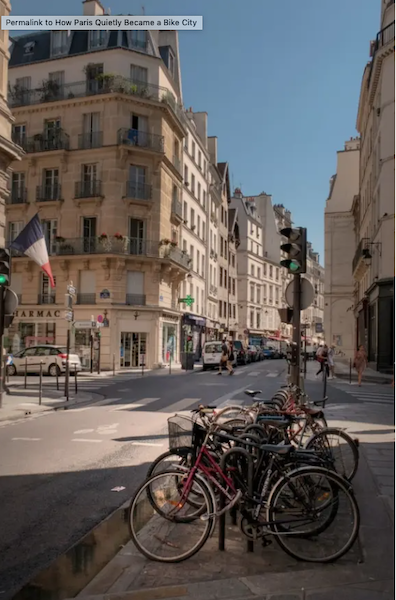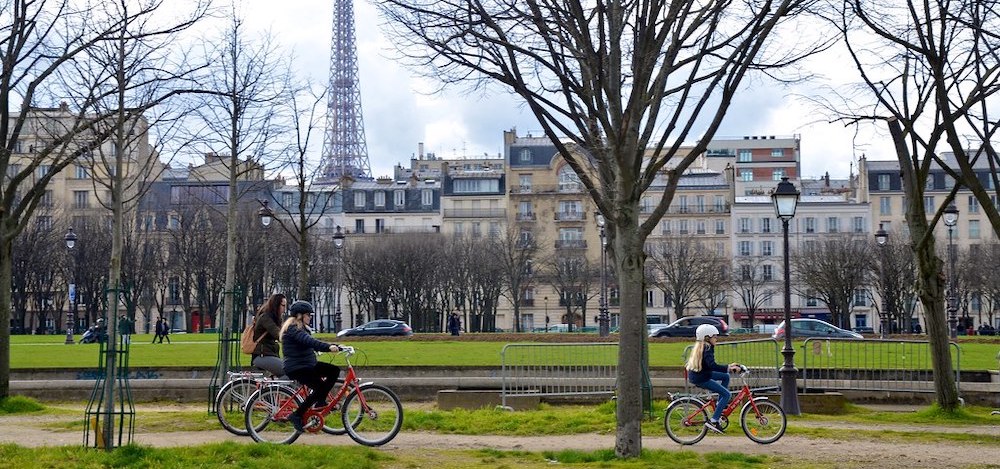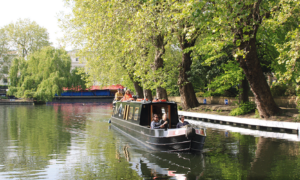(Editor’s note: This post about how Paris became a bike city originally appeared on The American In Paris blog. It’s reposted here with the permission of the author. You can jump to Pt. 2 here.)
When I moved to Paris in 2013, one of the first things I did was obtain a Navigo card and after a couple months of buying monthly passes manually via machines, I switched to an annual pass and have not had to think about topping up again. The metro was the way I moved about Paris.
But after getting to know the Metro fairly well you realize that it’s often just as easy to walk to a certain location and you start making choices about what form of transportation makes the most sense given the weather, your mood, what you’re carrying and what else you still need to accomplish. Velib was already around when I arrived in 2013 and the shared bike boom followed by the rise in trottinette usage meant that options for transport have only multiplied since then.
The one form of transport that has received an explosive infusion of support from local government is bicycles.
Infrastructure
Now that bike lanes are so well-established in Paris, I wonder how so many of us were brave enough to ride with vehicle traffic for many years prior. Cars and their drivers, convinced that everyone but them were simply “intruding” on their entitled space, didn’t make life easy for those of us on bicycles, but we figured that was simply the way it would be. I mean, this wasn’t Amsterdam after all. But little did most of us know that the Dutch model was exactly what Mayor Anne Hidalgo had in mind to transform Paris from the ground-up.
Plan Velo

Back in 2015, a year after Hidalgo’s first term began, the city started a project called Plan Velo. This was a big play to make it significantly easier for bicyclists to navigate the city by creating north-south and east-west reseaus express velos (REVes), or “bike express lanes.” Similar to what you are going to see on almost every street in the Netherlands, this is a protected bike lane that not only provides bidirectional traffic but also allows bikes to continue moving when their right-of-way is not impeded by traffic.
If you haven’t ridden in one of these before, you can’t possibly know how transformative it is. It changes the experience of bicycling in the city from one analogous to driving a car – i.e. having to always pay attention while being subject to a lot of traffic and stop lights – to one of breezy insouciance: these north-south and east-west corridors make point-to-point travel significantly faster, safer, and more pleasant.
Plan Velo has paid off in numerous ways, not least of which was featuring as the centerpiece of Hidalgo’s successful re-election bid as Mayor. Paris jumped up into the top ten of bicycle-friendly cities in the world during her first term. The infrastructure in place during the late 2019 transportation strike also allowed for an overnight 54% jump in bicycle use among Parisians, many of whom did not go back to the Metro even after the strike ceased.
Hidalgo also seized on Danton’s (in)famous notion of audace during the early days of Covid-19 and took back Rue de Rivoli, the longest street in Paris and limited it to one lane for buses and taxis. She also created a number of “coronapistes” which created new protected bike lanes via removable plastic cones. The reasoning given was that fewer cars were on the road because of lockdown and some people weren’t comfortable traveling in the confined spaces of the Metro. But, just as with the accompanying “extended terrasse” permissions given to the restaurants, rights ceded were not going to simply be given back, and now Plan Velo 2 has arrived.
Plan Velo, Acte 2
Part of the infrastructure changes needed to pérennisée both the so-called coronapistes and the extended restaurant outdoor terraces was removal of the largest enemy of vibrant life in any city: cars. Cars need a “home” in the form of parking places and 70% of the existing on-street parking spots designated for cars are being removed.
Hidalgo is running for president on the slimmest of chances and Plan Velo Acte 2, released last month (two days before her announcement to run for President), has to be seen as part of her case for progressive measures to form economic and social life at a granular level. The benefit is enormous for those of us who live in the city (Paris as 100-percent cyclable by 2026, it promises), but it’s doubtful that people outside of Paris really care, as life in the French countryside, like life almost everywhere in America, is unimaginable without cars. Indeed, such denizens would snort at her proposed 2030 gas-powered car ban, which seems quite reasonable to those of us who live in the capital, but might seem very odd to those who don’t.
That said, this plan involves investing 250 million euros to make the entire city bikeable by adding another 180 kilometers of dedicated two-way cycling paths in addition to making permanent the 52 kilometers Hidalgo and her team snuck in via the coronapistes last year (to put that in perspective, at the moment we already have more than 1,000 kilometers of bike paths, quite a few snaking into the suburbs). There’s also budget for more passenger and cargo bike parking spots and cleaning and trash removal for cycling paths.
In addition there will be programs to teach children to ride bikes in schools, repair workshops in each arrondissement, and a cycling tourism push.
(In Pt. 2, Stephen looks at the mindset shift needed to go along with the new biking infrastructure.)

About the author:
Singaporean-born American Stephen Heiner lived in Paris from 2013 to 2021 after living in Asia and the United States for most of his life. While he has an undergraduate degree in literature, he also has an MBA, and he’s very much the man who enjoys studying financial statements as much as he enjoys reading essays by G.K. Chesterton or James Howard Kunstler.
He visits his family in the U.S. and Singapore each year, but in the meantime enjoys his dream city, which he finally had a chance to move to after selling a company he built over a number of years.
You can find him on twitter and instagram @stephenheiner.
You can also follow his immigration journey on www.theamericaninparis.com, where Stephen also offers consulting to those interested in relocating to, and/or making a life in, France.
See more of Stephen’s Dispatches posts here.














